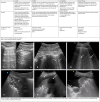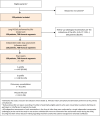Accuracy of point-of-care ultrasound examination of the lung in primary care performed by general practitioners: a cross-sectional study
- PMID: 40200132
- PMCID: PMC11978004
- DOI: 10.1186/s12875-025-02802-4
Accuracy of point-of-care ultrasound examination of the lung in primary care performed by general practitioners: a cross-sectional study
Abstract
Background: Lung ultrasonography (LUS) is a point-of-care imaging modality with growing potential in primary care.
Objectives: While its use is well established in hospital settings, data on its accuracy when performed by general practitioners (GPs) remain limited. This study aimed to assess the diagnostic accuracy of LUS conducted by GPs following structured training.
Methods: We recruited 17 GPs from various regions of the Czech Republic. They completed a two-day educational course focused on LUS. Patients with current dyspnoea (NYHA II-IV) or a history of dyspnoea within the last four weeks were included and underwent LUS to assess the presence of pleural effusion and interstitial syndrome. An independent expert sonographer, blinded to clinical data, evaluated recorded LUS video loops as the reference standard. LUS findings were categorized into A profile (presence of A lines and intact lung sliding, indicating normal aeration), B profile (three or more B lines per intercostal space in at least two intercostal spaces per hemithorax, suggesting interstitial syndrome), pulmonary consolidation and pleural effusion.
Results: A total of 128 patients were enrolled in the study. A total of 768 thoracic segments were examined. A profile was identified in 642 (83.6%) segments, B profile in 108 (14.1%), pulmonary consolidation in 8 (1.0%), and pleural effusion in 12 (1.6%). For the identification of A profile, the sensitivity was 97.51% (95% CI 95.98-98.57), and the specificity was 88.10% (95% CI 81,13-93,18); for B profile, the sensitivity was 87.04% (95% CI 79,21-92,73), and the specificity was 97.73% (95% CI96,28-98,72); for pulmonary consolidation, the sensitivity was 100.0% (95% CI 63,06-100,00), and the specificity was 100.0% (95% CI 99,52-100,0); for pleural effusion, the sensitivity was 83.33% (95% CI 51,59-97,91), and the specificity was 99.87% (95% CI 99,27-100,00).
Conclusion: Our findings provide important preliminary data, demonstrating that GPs can perform LUS accurately after a structured training program. THE TRIAL REGISTRATION IDENTIFIER: is NCT04905719.
Keywords: Accuracy; COVID-19; Lung examination; Point-of-care ultrasound; Primary care.
© 2025. The Author(s).
Conflict of interest statement
Declarations. Ethics approval and consent to participate: The study received ethical approval from the Institutional Ethics Committee of the University Hospital Hradec Králové on May 25, 2021, with reference number 202106 P10. The study was conducted in accordance with the Declaration of Helsinki and relevant national regulations. Patient inclusion in the study required informed consent to participate in the clinical study. All participants provided informed consent prior to their involvement. Consent for publication: Not applicable. Competing interests: The authors declare no competing interests.
Figures



Similar articles
-
Lung ultrasound has greater accuracy than conventional respiratory assessment tools for the diagnosis of pleural effusion, lung consolidation and collapse: a systematic review.J Physiother. 2021 Jan;67(1):41-48. doi: 10.1016/j.jphys.2020.12.002. J Physiother. 2021. PMID: 33353830
-
Lung ultrasound in internal medicine: A bedside help to increase accuracy in the diagnosis of dyspnea.Eur J Intern Med. 2017 Dec;46:61-65. doi: 10.1016/j.ejim.2017.07.034. Epub 2017 Aug 6. Eur J Intern Med. 2017. PMID: 28793969
-
Diagnostic accuracy and reproducibility of pleural and lung ultrasound in discriminating cardiogenic causes of acute dyspnea in the emergency department.Intern Emerg Med. 2012 Feb;7(1):65-70. doi: 10.1007/s11739-011-0709-1. Epub 2011 Oct 28. Intern Emerg Med. 2012. PMID: 22033792
-
Point-of-care lung ultrasound in young children with respiratory tract infections and wheeze.Emerg Med J. 2016 Sep;33(9):603-10. doi: 10.1136/emermed-2015-205302. Epub 2016 Apr 22. Emerg Med J. 2016. PMID: 27107052
-
Lung ultrasound in community-acquired pneumonia and in interstitial lung diseases.Respiration. 2014;87(3):179-89. doi: 10.1159/000357449. Epub 2014 Jan 28. Respiration. 2014. PMID: 24481027 Review.
References
-
- Poppleton A, Tsukagoshi S, Vinker S, Heritier F, Frappe P, Dupont F, et al. World organization of National colleges, academies and academic associations of general practitioners and family physicians (WONCA) Europe position paper on the use of point-of-care ultrasound (POCUS) in primary care. Prim Health Care Res Dev. 2024;25:e21. - PMC - PubMed
Publication types
MeSH terms
Associated data
LinkOut - more resources
Full Text Sources
Medical
